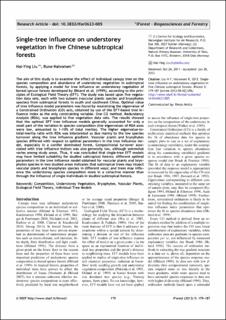| dc.contributor.author | Liu, Hai-Ying | |
| dc.contributor.author | Halvorsen, Rune | |
| dc.date.accessioned | 2020-04-14T12:27:12Z | |
| dc.date.available | 2020-04-14T12:27:12Z | |
| dc.date.created | 2012-11-26T13:10:12Z | |
| dc.date.issued | 2012 | |
| dc.identifier.citation | iForest : Biogeosciences and Forestry. 2012, 5 179-187. | en_US |
| dc.identifier.issn | 1971-7458 | |
| dc.identifier.uri | https://hdl.handle.net/11250/2650997 | |
| dc.description.abstract | The aim of this study is to examine the effect of individual canopy tree on the species composition and abundance of understorey vegetation in subtropical forests, by applying a model for tree influence on understorey vegetation of boreal spruce forests developed by Økland et al. (1999), according to the principles of Ecological Field Theory (EFT). The study was based upon five vegetation data sets, each with two subsets (vascular plants species and bryophytes species) from subtropical forests in south and southwest China. Optimal value of tree influence model parameters was found by maximizing the eigenvalue of a Constrained Ordination (CO) axis, obtained by use of the EFT-based tree influence index as the only constraining variable. One CO method, Redundancy Analysis (RDA), was applied to five vegetation data sets. The results showed that the optimal EFT tree influence models generally accounted for only a small part of the variation in species composition (the eigenvalues of RDA axes were low, amounted to 1-10% of total inertia). The higher eigenvalue-tototal-inertia ratio with RDA was interpreted as due mainly to the low species turnover along the tree influence gradient. Vascular plants and bryophytes species differed with respect to optimal parameters in the tree influence model, especially in a conifer dominated forest. Compositional turnover associated with tree influence indices was also generally low, although somewhat varies among study areas. Thus, it was concluded that single-tree EFT models may have limited suitability for studied subtropical forests; different optimal parameters in the tree influence model obtained for vascular plants and bryophytes species in two studied areas indicates that subtropical trees may impact vascular plants and bryophytes species in different ways; and trees may influence the understorey species composition more in a collective manner than through the influence of single individuals in studied subtropical forests. | en_US |
| dc.language.iso | eng | en_US |
| dc.rights | Navngivelse-Ikkekommersiell 4.0 Internasjonal | * |
| dc.rights.uri | http://creativecommons.org/licenses/by-nc/4.0/deed.no | * |
| dc.title | Single-tree influence on understorey vegetation in five Chinese subtropical forests | en_US |
| dc.type | Peer reviewed | en_US |
| dc.type | Journal article | en_US |
| dc.description.version | publishedVersion | en_US |
| dc.rights.holder | © SISEF - The Italian Society of Silviculture and Forest Ecology 2012 | en_US |
| dc.source.pagenumber | 179-187 | en_US |
| dc.source.volume | 5 | en_US |
| dc.source.journal | iForest : Biogeosciences and Forestry | en_US |
| dc.identifier.doi | 10.3832/ifor0623-005 | |
| dc.identifier.cristin | 964966 | |
| cristin.ispublished | true | |
| cristin.fulltext | original | |
| cristin.qualitycode | 1 | |

